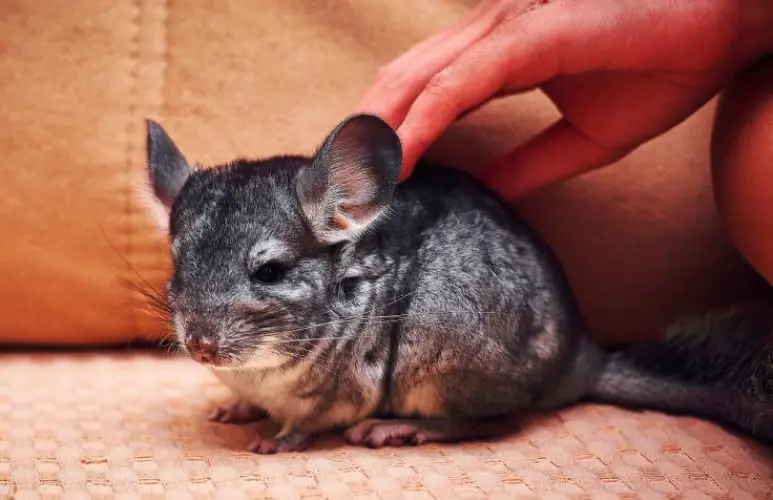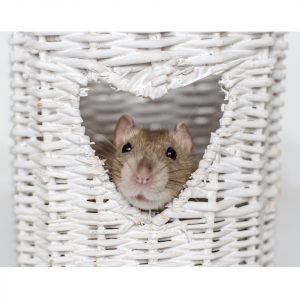There are quite a few choices if you consider getting an exotic pet. You may be interested in a pet rat but want to find a suitable alternative to brighten your life and make your family happy.
There are many alternatives to pet rats; you just need to figure out your interests.
If you consider a small pet that is not as high maintenance as a cat or dog, you have arrived at the perfect place. Check out this article and find the seven best pet rat alternatives.
What Are Some Alternatives to Pet Rats?
There are many alternatives to having a pet rat. If you want a pet like a rat, you must first figure out the size of the pet, how long they live, and even the care they require.
You can have something as small as a gerbil or as big as a chinchilla.
The following include various alternatives to having a pet rat:
Degus

A degu is as big as a guinea pig but is brown with a long, thin tail.
In the wild, they reside in groups of up to 100, the same way that prairie dogs do. They are one of the rare rodents that are wide awake during the day.
In some states, it is not legal for you to own a degu. That is something you should look into, just to be sure it’s safe to hold this kind of pet!
Degus tend to flourish in same-sex pairs of other degus. However, they may become belligerent if they do not get enough exercise or social interaction.
One thing you have to keep in mind is that you should never pick up a degu by its tail.
Degus can shed their tails as an anti-predator mechanism, but when this occurs, it causes a permanent injury, and their tail does not grow back. It is excruciating for them.
Some of the natural personality traits of degus include:
- Excited
- Energic
- Intelligent
- Playful
Degus communicate with each other through more than a dozen different sounds.
They will often stand up in their cage when their owner comes toward them, as they can recognize people and other degus.
This small rodent can be as friendly as a pet rat; the main difference is that they are smaller pets!
Syrian Hamsters
Syrian hamsters can also be called teddy bear hamsters, and they make excellent pets for children who are learning the value of taking care of an animal for the first time.

Teddy bear hamsters are the more significant type of hamster, as they are twice the size of the dwarf hamster.
They have a solid body and a stubby tail, which you can hardly see underneath their fur.
Hamsters are also highly energetic and usually run round and round on their hamster wheel.
These animals come in different coat colors:
- Beige
- Black
- Blonde
- Brown
- Chocolate
- Mink
Hamsters can also come in classic white, which may be the most popular color. Even lilac-colored hamsters have a light gray fur color with pinkish undertones, and there are many different types of color patterns of the Syrian hamster.
One striking color is tortoiseshell. Much like the tortoiseshell cat, some hamsters boast this gorgeous color pattern of caramel and black color.
Syrian hamsters tend to form strong bonds with their humans. They are lovely little creatures with good little hearts.
A strong point in their favor is that they usually do well with being the single pet rodent in the household, they don’t quite need a pair.
Gerbil

Gerbils are tiny members of the rodent family. They also make a great first pet for children.
These little creatures have furry bodies with long tails. Many people like to keep their gerbils in pairs.
They typically have paper or soft shaving for bedding. These animals are also very social and want to live in small family groups.
Family groups of gerbils tend to be quite affectionate and can even you’ll often find them cuddling together. Gerbils come in different colors:
- Black
- Buff
- White
- Gray
Gerbils can also have spotted coats. They are loving, curious, and energetic animals that, like hamsters, like to run on a wheel.
Chinchilla

Chinchillas are well-known for their very soft fur!
Chinchillas are very athletic and are known to jump great heights. Pet chinchillas have made it to the top of their owner’s refrigerator.
So, if they have the chance, they’ll jump onto everything!
They are very social and can live in groups of up to 100 chinchillas. They are nocturnal mammals, which means they sleep during the day and are active at night.
Some of the personality traits of the chinchilla include
- Intelligent
- Reserved
- Social
- Outgoing.
While shy at first, chinchillas can be outgoing when comfortable. They should, however, live indoors.
They cannot get wet under any circumstances due to their fur, as it can cause them to become very sick.
Curiously, chinchillas bathe themselves by revolving in a bowl filled with extraordinary, thin sand. You can easily find this sand or dust on Amazon, and it’s always so cute watching them roll around it!
It also happens that chinchillas are very affectionate animals. They can enjoy being pet and may even sit on your lap, like a smaller cat. Chinchillas are beautiful creatures.
Guinea Pig
Contrary to the name, guinea pigs are not pigs but are sweet rodents with curious eyes and fanciful expressions.
They can vocalize various sounds that have different meanings.
One of the unique traits of the guinea pig is called “popcorning”, just like with pet rats. They like to jump and twirl when they are happy or excited.

A guinea pig is the perfect family pet, as they are enjoyable to have around. They are also on the bigger side of rodents and enjoy roaming about your home while keeping you company!
Some of the personality traits of guinea pigs:
- Outgoing
- Energetic
- Clingy
- Gentle
Guinea pigs love social interaction, as they like to have a companion to play around with, so it’s generally a good idea to own more than one.
Even if they can bond with us, it’s never the same as interacting with their species!
Guinea pigs are also highly intelligent. You can teach them some tricks and games to deepen your bond.
Mice

Mice have a terrible reputation. Often considered “pests,” they can get into your house and cupboard and eat your food.
However, we are talking about pet mice, which are different. Mice have a pointy snout, round little ears, and a long tail. Mice are nocturnal creatures and are active at night.
They come in a wide variety of colors:
- Black
- Chocolate
- White
- Red
These animals can also come in other colors, like champagne, lilac, silver, and golden.
Mice have a rapid reproduction rate, so it is best not to put opposite-sex mice together unless you would like a lot of baby mice as pets.
Mice are a good alternative if you would rather have a smaller pet.
Other than that, they are very similar to pet rats!
In fact, I’ve compared both of them before. So if you’re on the fence, find out here if you should get a pet rat or a mouse.
Sugar Glider

Sugar gliders are popular exotic pets. They look like squirrels with gray fur and black markings.
To have a sugar glider as a companion, research them thoroughly before obtaining one. Sugar gliders are illegal in some states.
Since they are exotic pets found mainly in the wild, many people feel it is unethical to own a sugar glider.
They are highly social animals that need a lot of activities and a large living area.
Due to their nature, a lot of times, if not cared for correctly and without companions, if you take a sugar glider out of its natural environment, it will become depressed.
They make many different noises to let you know when they are hungry, frightened, or upset. It is essential to be gentle and handle them with care.
Some of the behaviors and temperaments of the sugar glider:
- Fast
- Adept climbers
- Intelligent
- Playful
Many people say that sugar gliders move like flying squirrels. If sugar gliders are socialized, they love to cuddle with their owners.
You must interact with the sugar glider regularly if you want them to bond with you. They are fun little animals, but they are very high maintenance.
So, in general, this is a pet to have when you are a more experienced pet owner with lots of space and the perfect conditions so they can live happily.
What Are the Key Characteristics of Each Animal?
Each animal has characteristics that are special to that particular animal. Each animal is unique and has its personality traits and behaviors.
They are all wonderful alternative pets to rats, sorted by size:
| NAME | ADULT SIZE IN INCHES | LIFESPAN IN YEARS | CHARACTERISTICS |
| Syrian Hamsters | 4 – 7 | 2 – 3 | Also called Teddy Bear They don’t need a companion |
| Mice | 5 – 7, including tail | 2 – 4 | Usually white with red eyes |
| Sugar Glider | 5 – 7 | 12 – 15 | Train to do tricks Not legal in some states |
| Gerbil | 8 – 10, including tail | 2 – 4 | Gerbils live longer with a mate |
| Degu | 9 – 12 | 6 – 8 | Not legal in some states |
| Chinchilla | 9 – 15 | 8 – 10 | Very soft fur |
| Guinea Pig | 8 – 16 | 3 – 5 | They come in many colors |
As you can see, you have a lot of choices when it comes to having a rodent for a pet. It depends on your preferences, your budget, and the space you have to own a pet.
It’s essential to research before owning a rodent since each has its particularities and care!
Conclusion
There are many alternatives to pet rats. You can have an energetic and excited gerbil, a cute and cuddly guinea pig, and even a soft and exotic chinchilla.
With that said, pet rats are a wonderful choice, in our opinion. Find out more here on how it really is like owning a pet rat.
Hopefully, this article has assisted you in learning more about what type of rodent pet you want to add to your family.
Sources:
https://www.thesprucepets.com/degus-as-pets-1236773
https://www.britannica.com/animal/guinea-pig
https://pethelpful.com/rodents/The-Complete-Guide-to-Pet-Mice




